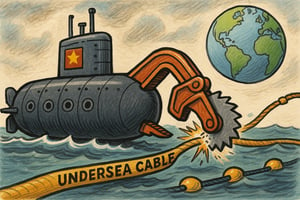When China’s state media proudly unveiled a new undersea cable cutter in March this year — a saw...
The Silence Before Breachfall: What Calm Teaches Us About Information Security

There’s something oddly unnerving about a quiet network. Everything is green. Logs are clean. Alerts haven’t chirped in days. Systems hum, updates tick along, and nobody’s raised a ticket.
And that’s when I worry the most.
See, information security rarely crumbles in chaos—it fails in silence.
That stillness? It’s not peace. It’s prelude.
In our line of work, we don’t romanticise the incident. We study the long breath before it.
The months of “normal” traffic before a nation-state actor exfiltrates terabytes under everyone’s nose.
The unmonitored admin account that’s been “just for testing.”
The file share no one’s touched in years—until someone did, and no one noticed.
Every breach we've worked on began with a shrug.
Every compromise hid in comfort.
And every regret started with: “But everything looked fine.”
Here’s the uncomfortable truth
Organisations are lulled into false confidence by uptime, dashboards, and the illusion of control.
We’ve mistaken no news for good security.
We audit. We patch. We feel virtuous.
Then we forget to ask the one question that matters:
“Who is watching the watchers?”
What if the quiet is the threat?
Attackers don’t bash down the front door anymore.
They move like ghosts in the HVAC.
They hide in business logic, API tokens, or outdated assumptions about trust.
They’re not here to create noise—they’re here to blend in.
Which is why the organisations I respect the most aren’t the ones with the flashiest EDR,
or the most compliant checklists,
or the million-dollar SOC.
It’s the ones that treat calm like it’s suspicious.
It’s the teams that run wargames when there’s no war.
It’s the leaders who ask, “What would an attacker see if they were already inside?”
Not to be paranoid. But to be prepared.
The false god of the ‘clean report’
Let me be blunt.
Too many security programs exist to impress auditors, not to deter adversaries.
I’ve seen organisations spend more on the appearance of security than its substance.
Perfect documents. Perfect dashboards. Perfect disasters waiting to happen.
Because the enemy doesn’t care how well you scored on your last risk register.
They care about that one thing you missed.
That one “temporary” rule in the firewall.
That one personal Gmail account used by your CFO.
So here’s my advice:
Get uncomfortable with silence.
Treat every period of calm as an opportunity to simulate, reflect, and reassess.
Don’t just run tabletop exercises—red team your culture.
Build an organisation that doesn’t wait for a breach to start listening.
Because when the next big storm hits,
it won’t announce itself with fanfare.
It’ll whisper.
Just like it always does.
Stay alert, stay humble, and stay human.
.png?width=1000&height=500&name=Shimazaki%20Sentinel%20Logo%20-%20Post%20Pitch%20(Normal).png)


